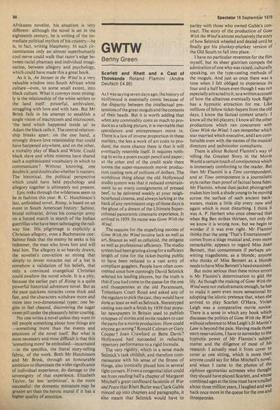GVVTW
Benny Green Scarlett and Rhett and a Cast of Thousands Roland Flamini (Andre Deutsch £4.95) As I was saying seven days ago, the history of Hollywood is essentially comic because of the disparity between the intellectual pretensions of the great moguls and the contents of their heads. But it is worth adding that when any commodity costs as much to produce as a talking picture, it is inevitable that speculators and entrepreneurs move in. There is a law of inverse proportion in these matters; the less a work of art costs to produce, the more chance there is that it will eventually resemble itself. It requires nothing to write a poem except pencil and paper; at the other end of the credit scale there looms the super-mammoth movie production costing tens of millions of dollars. The wondrous thing about the old Hollywood studio system was that it reduced entertainment to so many consignments of pressed beef, to be delivered weekly at your neighbourhood cinema, and always lurking at the back of any reminiscent orgy of those days is the ghost of a dream of the Ultimate Supercolossal panoramic cinematic experience. It arrived in 1939. Its name was Gone With the Wind.
The reasons for the stupefying success of Gone With the Wind involve luck as. well as art, finance as well as celluloid, the zeitgeist as well as professional efficiency. The studio system had been grating along for a sufficient length of time for the ticket-buying public to have been reduced to a vast army of compliant gogglers. People have often commented since how cunningly David Selznick selected his leading players, but the truth is that if you had come to the queue for the one and threepennies at the old Paramount, Tottenham Court Road and asked any of the regulars to pick the cast, they would have done at least as well as Selznick. Stereotyped casting was such a fetish by 1939 that popular newspapers in Britain used to publish synopses of stories and invite readers to cast the parts for a movie production. How could anyone go wrong? Ronald Colman or Gary Cooper? Joan Crawford or Bette Davis? Hollywood had succeeded in reducing repertory performance to a rigid formula.
The very rigidity, which in a sense made Selznick's task childish, and therefore commensurate with his sense of the fitness of things, also ironically placed him in several tight corners. If even a congenital idiot could see from reading half a chapter of Margaret Mitchell's great cardboard facsimile of War and Peace that Rhett Butler was Clark Gable minced up into chapters and paragraphs, it also meant that Selznick would have to parley with those who owned Gable's contract. The story of the production of Gone With the Wind is almost exclusively the story of how Selznick wheeled and dealed until he finally got his plunkey-plunkey version of the Old South to fall into place.
I have no particular reverence for the film myself, but its sheer giantism compels the admiration of one who was raised, culturally speaking, on the type-casting methods of the moguls. And just as once there was a time when I felt obliged to experience its four and a half hours even though I was not especially attracted to it, so a written account of how the albatross eventually took flight has a hypnotic attraction for me. Like millions of fellow ticket-buyers from the old days, I know the factual context utterly. I know all the bit-players; I know all the other productions which ran concurrent with Gone With the Wind; I can remember which star married which executive, and I am comfortable even with the names of the musical directors and technicolor consultants.
There is about Roland Flamini's way of telling the Greatest Story in the Movie World a certain touch of omnipotence which is immensely comforting to the reader. But then Mr Flamini is a Time correspondent, and at Time omnipotence is a journalistic style rather than proof of factual bona fides. Mr Flamini, whose dust-jacket photograph makes him look a shade young to be moving across the surface of such ancient backwaters, makes a little slip every now and again which is most disturbing. I think it was A. P. Herbert who once observed that when Big Ben strikes thirteen, not only do we know it is wrong now, but we begin to wonder if it was ever right. Mr Flamini thinks that the song 'That's Entertainment' comes from a stage musical and, even more remarkable, appears to regard Miss Joan Bennett, that consummate if perhaps unwitting tragedienne, as a blonde; anyone who thinks of Miss Bennett as a blonde needs to have Miss Bennett's head examined.
But more serious than these minor errors is Mr Flamini's determination to gild the lily. As though the making of Gone With the Windwere not melodramatic enough, he has to make it seem even more sensational by adopting the idiotic pretence that, when she arrived to play Scarlett O'Hara, Vivien Leigh was a comparative movie novice. There is a sense in which any book which discusses the politics of Gone With the Wind without reference to Miss Leigh's St Martin' s Lane is beyond the pale. Having made those stern reservations, I have to surrender to the hypnotic power of Mr Flamini's subject matter and the diligence of most of his research. I actually read it from cover to cover at one sitting, which is more than anyone could say for Miss Mitchell's novel, and when I came to the photos of the eighteen egomaniac actresses who thought they should have played Scarlett, and whose combined ages at the time must have totalled about three million years, [laughed and Was back once more in the queue for the one and threepennies.





































 Previous page
Previous page